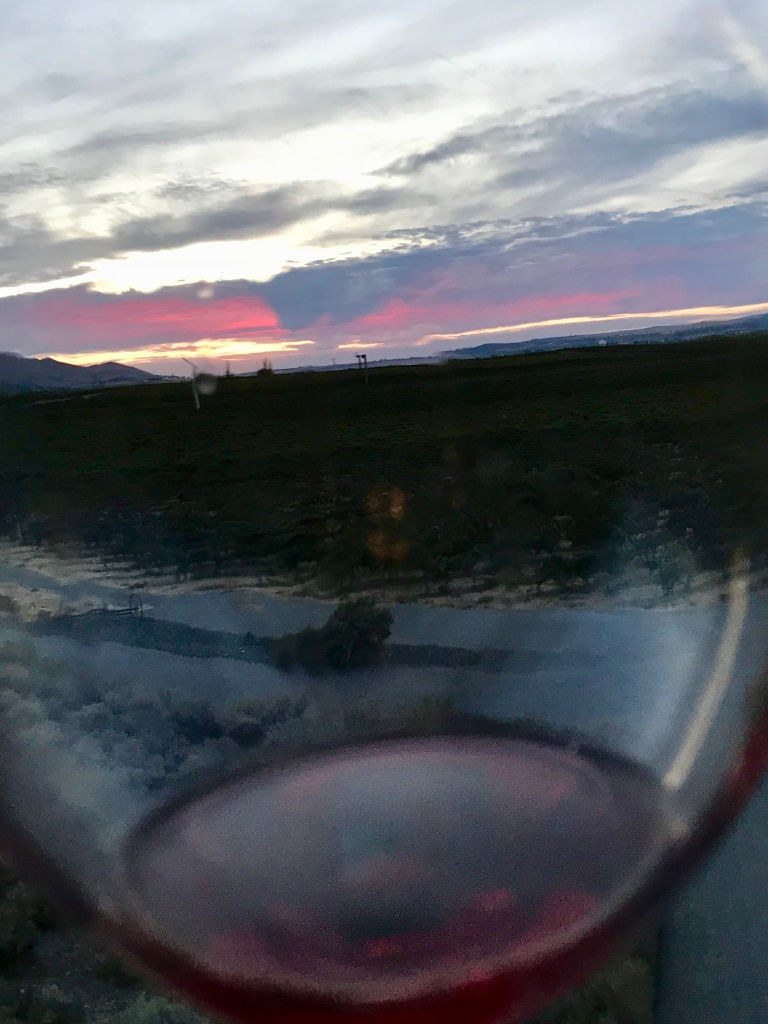From Dust to Density: The Powerful Allure of Red Mountain Wines (part two)
- Melanie Webber

- Oct 4, 2019
- 5 min read
Updated: Mar 7, 2024
Part Two: Five Pillars to World Class Wine

JJ Williams, Director of Operations, Whippersnapper
I grew up on Red Mountain, where my childhood was spent stacking and unstacking ladders, balancing shovels on my outstretched palm, and wondering why we couldn’t have cable television like “normal” kids
- JJ Williams
The Five Pillars
One could not find a more enthusiastic evangelist for Red Mountain than JJ Williams, grandson of Kiona’s founder and a millennial who has spent his life in the dusty vineyards of Red Mountain. Before hosting our group of wine writers for a “Red Mountain in the World” blind tasting showdown, he ran us through the five pillars of Red Mountain that enable Washington’s smallest AVA to produce world-class wines that possess such richness and intensity:
Slope – gentle, south-west facing, ideal for the kind of prolonged sunlight exposure and warmth that ripens the grapes and their tannins.
Aridity – 5 – 6 inches of rain a year and none during fruit set and harvest; this means growers can control water to vines, also means no mildew pests.
Wind – regular warm gusts of wind means smaller berries which intensifies fruit/reduces fungus
Good Dirt – high alkalinity, good drainage, low nitrogen, plants struggle so their roots reach deep and concentrate the fruit (more on this amazing dirt in Part 3)
Heat/sunshine – 16 – 17 hours of sunlight a day (2 more than Napa) = ripe, concentrated grapes; but, its cool nights mean grapes high in both sugar and acidity
These pillars produce wines of dense complexity, with a richness of flavor, that nevertheless is more nuanced, in my opinion, than so many California reds – the restraint of Bordeaux with a level of bright intensity that can knock you off your feet. JJ also stressed that while their wines need to achieve a style that enhances marketability, their use of oak is restrained: ‘the least amount possible is the right amount.’
I say amen to that!!
Red Mountain in the World

JJ set us up with a comparison blind tasting that pitted wines from around the world against Red Mountain wines as follows (although we didn’t know the identities while we were tasting):
Chateau de Perez from St. Estephe in Bordeaux compared with Hedges Red Mountain Cabernet 2015
Brancaia Super Tuscan 2013 (Italy) compared with Col Solare Cabernet 2015 (Antinori/Ste. Michelle Red Mountain venture)
Chappellet Cabernet from Napa Valley compared with Fidelitas Cabernet 2015 (Red Mountain)
McLaren Vale Hickinbothen Trueman Cabernet compared with Hightower 2014 Cabernet (Red Mountain Cabernet with 10% Malbec/10% Merlot)

What I found most interesting about the tasting was that it was not so much a quality competition – the quality was consistently high across the board – but was more about how these wines intersected stylistically, where they diverged and the unique hints that broadcast the Red Mountain wines. It was not always easy to know which was which, and I stumbled on a couple, but the more I tasted, the more the Red Mountain wines revealed their special identity.

So what is that identity? The fruit was, indeed, profound, concentrated and almost exotic in each of the Red Mountain wines, but I also found an almost ashy/mineral quality in some of the wines that was distinct from, and yet reminiscent of, the more austere and stony graphite of the St. Estephe. And where the McLaren Vale Trueman had dark, shadowy fruit with savory notes, the Hightower it was compared to had ripe, but elegant, fruit seasoned with minty eucalyptus that could easily have identified it with an Australian provenance.
So – Red Mountain? Exquisite, concentrated densely wrought fruit developing into complex flavors that can be savory and/or herbaceous, and all displaying brisk acidity and round mouthy tannins. Could they be mistaken for wines from other regions? Of course – that is part of their mystique.
To me they are the other side of the sun in a bottle…. nuanced, fruitful and delicious.

Cyclops III andNyx, small production Kiona Rhone blends, available only to wine club members
While there were no Kiona wines in the blind tasting, JJ couldn’t resist opening up some of Kiona’s small production “edgier’ cuvees that are only available to club members: Nyx and Cyclops III blended from different proportions of Mourvedre, Syrah and Grenache, proving that Rhones can be as at home in Red Mountain as Bordeaux.
They did not disappoint.

After a final view of the sunset, we ended as we had begun the day – with Hedges, who had kicked us off with bubbles. We were driven about a mile or two up the hill for an evening party at their estate winery which is a simply stunning chateau, evoking wineries I have visited in France.

Hedges Family Estate Chateau
The picture-perfect chateau, intricately landscaped, dotted with fountains and stunning views, possesses an old world grace that puts you firmly in France, while its vineyard vistas open up onto what owner and founder Tom Hedges calls the “Wild West of Vines.”
Tom and Annie-Marie purchased 50 acres of Red Mountain in 1989, planting only Bordeaux varieties and broke ground on their chateau in 1995. They have won numerous accolades and gold medals for their wines including a Top 100 Wines designation from Wine Spectator. Their dark, plush 2015 Red Mountain Cabernet with a constantly evolving finish was one of my favorites of the Red Mountain in the World comparative tasting.

Sarah Hedges Goedhart, Head winemaker for Hedges
At Hedges, winemaking and production is also a family affair: today their daughter Sarah is the head winemaker while son Tom is General Manager. In 2018, they converted their estate vineyard to biodynamic wines and today produce principally Bordeaux grapes and Syrah on 120 acres.
As sunset slipped into nightfall, many of the Red Mountain wineries joined us for a stunning spread of food served in the elegant chateau kitchen and it could not have been clearer that family in Red Mountain does not just refer to the family wineries, but the overall ethos of the Red Mountain AVA – a true family of winemakers still making and made by this unique and intriguing ‘mountain’.
Visit!
Red Mountain is, unlike many other wine regions, very manageable and relatively compact, with about 20 wineries, it is definitely worth putting on your Washington wine trail itinerary. All the winemakers I met were friendly, down to earth and passionate about their wines, very forthcoming with information and deeply proud of Red Mountain – and each had great stories about their winery’s origin. And, my early comments notwithstanding, this dusty AVA will soon wrap you in its magic, especially the play of light and clouds on Red Mountain! Part 1:We made Red Mountain, Red Mountain made us
Kiona Vineyards and Winery https://www.kionawine.com/
Hedges EstateWinery https://www.hedgesfamilyestate.com/
Hightower https://www.hightowercellars.com/
Col Solare https://www.colsolare.com/
Fidelitus http://www.fidelitaswines.com














Comments